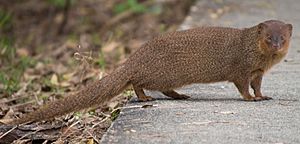Javan mongoose facts for kids
Quick facts for kids Javan mongoose |
|
|---|---|
 |
|
| Conservation status | |
| Scientific classification | |
| Genus: |
Herpestes
|
| Species: |
javanicus
|
| Subspecies | |
|
H. j. javanicus |
|
 |
|
| Javan mongoose range | |
The Javan mongoose (scientific name is Urva javanica) or small Indian mongoose is a small, furry mammal that lives in parts of Southeast Asia.
Contents
What does it look like?
Its body is slender and the head is elongated with a pointed snout. The length of the head and body is 509–671 millimetres (20.0–26.4 in). The ears are short. The feet have five toes and long claws. Sexes differ in size, with males having a wider head and bigger bodies.
The Javan mongoose has fur that can range in color. It's often described as being reddish-brown to a darker brown, and a rich yellowish-brown color on its back. It has short hairs on its ears. Its tail gets thinner towards the end, like a cone shape. They are built for speed and agility, which helps them catch their food.
Where do they live?
The Javan mongoose is native to (meaning it naturally lives in) several countries in Southeast Asia. These include Myanmar, Thailand, Cambodia, Vietnam, Laos, the part of Malaysia that's on the mainland (Peninsular Malaysia), and the Indonesian islands of Sumatra and Java.
They can live in different kinds of places, from low-lying areas all the way up to mountains as high as 1,800 meters (that's about 5,900 feet!).
Behavior
The Javan mongoose is mostly a solitary animal, meaning it likes to live by itself. However, sometimes males form social groups and share burrows.
Diet
They eat mostly insects but are opportunistic feeders and will eat crabs, frogs, spiders, scorpions, snakes, small mammals, birds and eggs.
Reproduction
Females are pregnant for up to 49 days and give birth to a litter of 2–5 young. Males can potentially become sexually mature at the age of 4 months.
Invasive species
The mongoose was introduced onto Okinawa Island in 1910 and Amami Ōshima Island in 1979 in an attempt to control the population of the venomous snake Protobothrops flavoviridis, an endemic species, and other pests, but they have since become pests themselves. In 2016, the European Commission put the mongoose on the list of invasive alien species in the EU. This means that in all the countries that are part of the European Union, people are not allowed to bring this species in, breed them, move them around, sell them, or let them go into the wild on purpose. This rule is in place because invasive species can sometimes harm the local plants and animals or cause other environmental problems.
In the 1800s sugar cane plantations shot up on many tropical islands, including Hawaii, Fiji and Jamaica. With sugar cane came rats, attracted to the sweet plant, which caused crop destruction and loss. Attempts were made to introduce the mongoose in Trinidad in 1870 to control the rats. Although mongoose introduction was very successful in rat control, the mongoose also hunts reptiles, birds and bird eggs, threatening many local island species.
Challenges
Even though Javan mongooses can adapt to different places and eat many things, they still face some challenges.
In Sumatra, one of the islands where they live, Javan mongooses are sometimes caught from the wild to be sold as pets. Surveys done between 1997 and 2001 at wildlife markets showed that the Javan mongoose was the animal most often being sold there.
Despite being hunted quite a bit in countries like Laos, Thailand, and Vietnam, they are still seen fairly often, even in areas near towns and cities. This suggests they are quite resilient and can live alongside people to some extent.
Interesting facts about the Javan mongoose
- For a while, another mongoose, called the small Indian mongoose (Urva auropunctata), was thought to be just a type (subspecies) of the Javan mongoose. However, they are actually two different species!
- Mongooses can carry leptospirosis and rabies (although actual incidence of transmission to humans is low).
- The Javan mongoose uses about 12 different vocalizations.
See also
 In Spanish: Meloncillo de Java para niños
In Spanish: Meloncillo de Java para niños


